Commercial cardio machines are designed with heavy use in mind, making them ideal for commercial gyms, communal fitness areas, and houses full of cyclists. The best commercial exercise bikes, like the best exercise bikes, can withstand constant use while offering a variety of training options that can accommodate a steady stream of users. With durable steel frames and heavy flywheels, they’re as suited for intense HIIT sessions as they are long, leisurely rides.
Our team of experts have assembled our picks for the best commercial options on the market, but before you can find your match made in cardio heaven, there’s a few questions you should ask. Who will be climbing in the saddle? What space do you see it calling home? Maybe you’re looking for a new addition to your commercial gym or hoping to beef up the fitness center at an assisted-living facility. Or maybe your home gym just needs a high-quality bike that can last for years. Take a look at our top picks for commercial exercise bikes to see if one of these options checks all your boxes.
The 8 Best Commercial Exercise Bikes for 2025
- Best Overall Commercial Exercise Bike: NordicTrack Commercial S22i
- Best Peloton-Alternative Commercial Exercise Bike: ProForm Studio Bike Pro 22
- Best Commercial Air Bike: Assault Fitness AssaultBike Classic
- Best Smart Commercial Exercise Bike: Echelon Connect EX-8s
- Best Budget Commercial Exercise Bike: Yosuda YB001R Magnetic Exercise Bike
- Best Recumbent Commercial Exercise Bike: NordicTrack Commercial R35
- Best Commercial Exercise Bike with a Screen Holder: ProForm Carbon CX
- Best Commercial Exercise Bike for Motivation: Peloton Bike
How We Tested and Chose the Best Commercial Exercise Bikes
When the BarBend team of fitness professionals hops into the saddle, we bring our years of experience as certified personal trainers, USA Weightlifting coaches, and gym owners to every ride. We’ve spun the dual-sided pedals on over 20 bikes and worked to document our experiences on top models from leading brands to back you up as you think about making this investment in your fitness.
We took note of each bike’s construction, the types of training they support, and whether or not we really needed that huge touchscreen. During testing, we assigned ratings of 1 (ouch) to 5 (oh, yeah) across 12 different categories, including value, footprint, durability, and tech capabilities. Here are a few of the key factors that informed our picks.
Longevity
With such heavy usage, commercial exercise bikes need to be able to hold up over time. When making our picks, we scrutinized each bike’s construction and only included options with steel frames and weight capacities between 250 and 350 pounds that can stand up to constant use.
[Related: The 9 Best Exercise Bikes For Heavy People]
Most of our picks feature flywheels over 30 pounds, as heavier, more durable flywheels can provide smoother resistance adjustments and hold up better over time. The weight capacities on these bikes range from 250 pounds (on our compact pick) to 350 pounds (the top of the average range of 300 to 350 pounds).
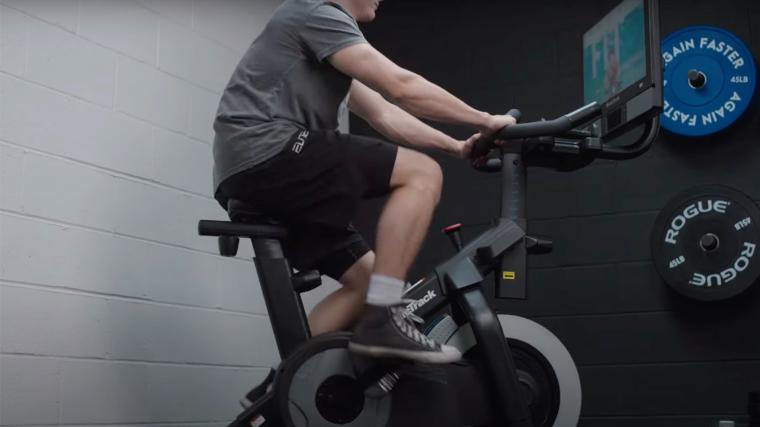
All of our picks (save for the air bike), use magnetic resistance, which we’ve found requires less maintenance over time than friction systems that utilize brake pads. Since the resistance is regulated by magnets on both sides of the flywheel, these heavy parts don’t come into contact, prolonging their lifespan. (1)
Versatility
In a commercial setting where multiple people will be using an exercise bike, it’s important that it can support multiple types of training, from endurance to intervals and sprint workouts. Since users of a multitude of fitness levels and goals may be climbing abroad, we sought to include models with wide resistance ranges, integrated programming, and, in some cases, incline and decline functionality. We also included an air bike and a recumbent bike for those looking for a CrossFit-friendly model and one that’s easier on the joints.

You’ll also find a variety of footprints and display sizes to suit your training space and clientele. Whether you need bikes that can easily roll to make space for ellipticals or treadmills, or you’re making the bike a permanent fixture in your gym, we’ve got you covered.
Price
While the heavy-duty builds and tech features of commercial exercise bikes typically mean they cost more than at-home models, we worked to include a few budget options that we think can stand up to heavy use.
[Related: The 8 Best Exercise Bikes Under $500]
Our picks range from $279 to $3,079, but most fall between $1,000 and $2,000. Options at the lower end of that range may lack the tech and conveniences of more expensive models, but they’ll still make you sweat.
Best Overall Commercial Exercise Bike: NordicTrack Commercial S22i

The NordicTrack Commercial S22i is high-tech and high quality, featuring both advancements like a 22” touchscreen display, and solid specs like 24 levels of quiet magnetic resistance.
Specs
- Price: $1,999
- Dimensions: 58″ H x 61″ L x 22″ W
- Display: 22” HD touchscreen
- Weight: 205lbs
- Resistance: 24 levels of magnetic resistance
- Weight Capacity: 350lbs
Pros
- With its steel frame, 32-pound flywheel, and 10-year warranty, this well-rounded bike is in it for the long haul.
- Use iFIT to hop into a live studio class or follow scenic rides from around the world via the 22-inch HD touchscreen.
- The -10 percent decline and 20 percent incline are uncommon among exercise bikes — even commercial options.
Cons
- Between its 205-pound overall weight and 9.42-square-feet footprint, moving the bike around can be difficult.
- Its $1,999 price tag is at the top of the average price range for commercial bikes — $1,200 to $2,000.
The NordicTrack S22i is our pick for the best overall commercial exercise bike because it has the build and features to make it one of the centerpieces of your gym. The steel frame can support users up to 350 pounds, and its 32-pound flywheel allows for smooth adjustments across its 24 resistance levels. Over 17,000 live and on-demand iFIT classes are available via the 22-inch HD touchscreen, which users can tilt and rotate to for off-bike workouts like strength training, yoga, or Pilates.

Even among commercial bikes, incline and capabilities are rare — much less a -10-percent to 20-percent range. This feature can help riders trying to mimic outdoor rides during cardio workouts at home or in the gym, and is especially useful given iFIT’s automatic resistance control. While you can adjust the resistance with the buttons on the handlebars, the knob on the frame, or from the screen, the resistance can also be adjusted hands-free during a live class or as you follow a scenic route. That way, you can just focus on your sweat.

Certified personal trainer Kate Meier particularly enjoyed her ride in Hawaii, following the rises and dips along the coast. “Having incline and decline really brought that Hawaii ride to life,” she said, rating the dynamic programming on the S22i a 5 out of 5.
While its $1,999 price tag is at the top of the average price range for commercial bikes — $1,200 to $2,000 — Meier still rated its value 4.5 out of 5. “I mean, this bike has it all. Big touchscreen, incline and decline, and the price is in the Peloton range. Without an iFIT subscription, though, it wouldn’t be very impressive.”
It is a cumbersome machine, though. Between its 205-pound overall weight and the screen throwing off her balance, Meier had trouble moving it around. “There isn’t a handle or obvious place to grab to tilt it,” she pointed out. “Once I did lift it up, the screen kind of threw it off balance.” After rating its footprint and portability 3.5 out of 5, Meier concluded this commercial bike is better off staking out a permanent spot in your gym.
Read our full NordicTrack S22i Exercise Bike Review.
Best Peloton-Alternative Commercial Exercise Bike: ProForm Studio Bike Pro 22

The ProForm Studio Bike Pro 22 is a high-tech, high-quality indoor bike. It has a 22” HD touchscreen display that swivels 180 degrees to accommodate workouts both on and off the bike. It comes with a free year of iFit and features silent magnetic resistance making it a great option of in-home use.
Specs
- Price: $1,299 — or free with 3-year iFIT membership
- Dimensions: 54” H x 56.5” L x 21.9” W
- Display: 22” HD touchscreen
- Weight: 144lbs
- Resistance: 24 levels of magnetic resistance
- Weight Capacity: 250lbs
Pros
- You can experience iFIT’s 17,000+ live and on-demand classes with top-notch instructors via the immersive 22-inch HD touchscreen.
- ProForm offers the bike for free when you commit to an iFIT subscription for three years — $39.99 per month for 36 months or a one-time $1,404 payment.
- The heavy-duty steel frame and 32-pound flywheel can provide a sturdy and stable ride, with a 10-year frame warranty to back it up.
- Such a heavy flywheel allows for smooth adjustment of the 24 levels of magnetic resistance.
Cons
- The screen made moving it a bit around our gym tough because the large display threw off its balance.
- Its 250-pound weight capacity is 47 pounds less than the Peloton Bike.
If you’ve been hesitant to join Team Peloton, we think the ProForm Studio Bike Pro 22 is the best alternative among commercial exercise bikes. Its 22-inch HD touchscreen is a half-inch larger than the Peloton Bike, and on it you can access more than 17,000 live and on-demand classes via iFIT, which we find to be a worthy competitor to Peloton. Our team consistently rates iFIT’s programming a 5 out of 5. “After all my time using iFIT, I think it has emerged as Peloton’s only true competitor,” said one of our testers.

It’s also worth noting that this ProForm machine is actually free with a 3-year iFIT membership. You can either pay over time ($39 per month for 36 months) or all at once ($1,404). A 3-year Peloton membership, meanwhile, comes out to $1,584 — add that onto the $1,445 price tag for the Peloton Bike and that amounts to $3,029, more than $1,500 more than the Studio Bike Pro 22 with three years of iFIT.
[Related: iFit Review – Is Virtual Coaching The New Normal?]
Another tester, a certified personal trainer with hundreds of iFIT workouts under their belt, rated the Studio Bike Pro 22’s value 4 out of 5. “While I’m not sure the actual bike is as nice as the Peloton Bike, getting it along with three years of iFIT obviously increases its value.”
So let’s talk about the actual bike. We love its sturdy steel frame and 32-pound flywheel, which allows for smooth resistance adjustment. When I had the chance to take it for a spin, the build helped it earn a 5 out of 5 for durability from yours truly. There was zero wobble, even at high speeds.

One area of concern is its 250-pound weight capacity. At 47 pounds less than the Peloton Bike, this is more in line with budget options like its little brother, the ProForm Carbon CX, or the Yosuda YB001R. You’ll also want to be careful when moving it — a 22-inch touchscreen can be cumbersome and awkward during transport.
Read our full ProForm Studio Bike Pro 22 Review.
Best Commercial Air Bike: Assault Fitness AssaultBike Classic

The Assault AirBike is a moderately priced bike with a solid build that features a powder-coated steel frame. It’s an upright indoor bike with moving arms that’s designed to burn calories and integrate seamlessly into cross-training and interval workouts.
Specs
- Price: $699
- Dimensions: 50’’ H x 50.95’’ L x 23.34’’ W
- Display: LCD screen
- Weight: 95.6lbs
- Resistance: Air
- Weight Capacity: 300lbs
Pros
- Its air-powered resistance and moving arms allow for CrossFit-friendly full-body air bike workouts.
- Between its powder-coated steel frame, reinforced pedals, and 20 sealed cartridge bearings, this bike is built to last.
- You can access seven built-in workouts from the LCD display on the console.
Cons
- Compared to belt-driven air bikes, its chain-drive system can be noisy.
- It’s light on tech, with no speakers or Bluetooth compatibility.
The steel frame, adjustable seat, and 300-pound weight capacity of the AssaultBike Classic make it an easy pick for commercial settings filled with a variety of different athletes. You’ll get the durability and longevity in the build, while allowing a wide variety of athletes to get a full-body burn using the moving arms. Its durability and value both earned a 4 out of 5 or higher from our tester. “All of Assault’s bikes are incredibly durable, and given the high-intensity exercises they support, they’re built for heavy use,” they said.
A staple in CrossFit gyms, air bikes serve many purposes. Our expert reviewer, Amanda Capritto, CPT, CF-L1, CES, CSNC, detailed out how they compare with other exercise bikes. “They are great for high-intensity training as well as slow, steady recovery work,” she says. “Compared to regular bikes and indoor bikes, air bikes engage more of the body’s musculature due to the moving arms. The nature of the fan flywheel means that the only limitation in resistance and speed is the exerciser themself.”
When he broke down his experience on the AssaultBike Classic in the video below, Jake Herod, NASM-CNC, felt the burn as well. “Since you are required to use your upper body, you’re going to be burning a lot of extra calories,” he said.
The AssaultBike Classic is built to last, with a powder-coated steel frame and sealed cartridge bearings. Whether it’s in a commercial gym, home gym, or living room, our tester thinks this air bike will hold up for a long time. “The best air bikes can last for years even under heavy usage,” they explained.
While its chain drive system may be noisier than a belt-driven competitor like the Rogue Echo, Capritto also noted they can bring a bit more intensity. “I can get to 50 calories much quicker on an Assault Bike than I can on an Echo Bike,” she says.
Air bikes tend to be low on tech, and the AssaultBike Classic is no exception. It has no speakers or Bluetooth connectivity, though it does have seven pre-programmed workouts on the LCD console. But since many athletes use air bikes for short bursts of high-intensity pedal-pumping, tech isn’t really a necessity.
Read our full Assault AirBike Review.
Best Smart Commercial Exercise Bike: Echelon Connect EX-8s

The Echelon EX-8s can glam up your home gym with a dual-flywheel design outfitted with LEDs you can customize by color, tempo, and brightness. The 24-inch touchscreen is curved to offer a deeper sense of immersion during classes on the Echelon Fit app.
Specs
- Price: $3,079
- Dimensions: 65’’ H x 59’’ L x 23’’ W
- Display: 24” curved HD touchscreen
- Weight: 124lbs
- Resistance: 32 levels of quiet magnetic resistance
- Weight Capacity: 300lbs
Pros
- This tech-savvy bike has a curved 24-inch HD touchscreen, customizable flywheel lights, and a Bluetooth resistance controller.
- Access more than 15,000 live and on-demand workouts via the Echelon Fit app.
- The steel frame and heavy 38-pound flywheel can withstand daily use.
- Its built-in shock absorption system can help lessen the force taken on by your joints, especially when you rise out of the saddle.
Cons
- The extra weight and position of the screen may affect its mobility.
- At $1,079 more than the comparable NordicTrack S22i, the price tag may be tough to swallow.
With high-tech features like customizable flywheel lights, an app-integrated curved touchscreen, and a Bluetooth resistance controller, the Echelon Connect EX-8s was an easy choice for the best smart commercial exercise bike. Beyond the tech, its steel frame — capable of supporting up to 300 pounds — includes a unique shock absorption system that can help reduce the impact taken on by your joints, especially when you stand up for a sprint or try to climb a virtual hill on a scenic ride.
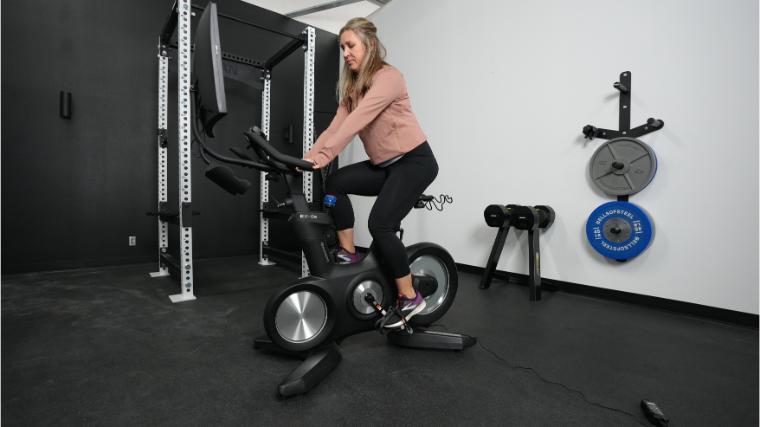
Because the EX-8s is locked into the Echelon ecosystem, you’ll need a membership to access anything outside of Freestyle mode. For $39.99 per month, though, you can set up five profiles, allowing multiple users to track their metrics and set their preferences. When it was first released, the EX-8s didn’t support third-party streaming apps, but you can now watch Netflix, Amazon Prime, or Disney+ right on the curved 24-inch HD touchscreen.
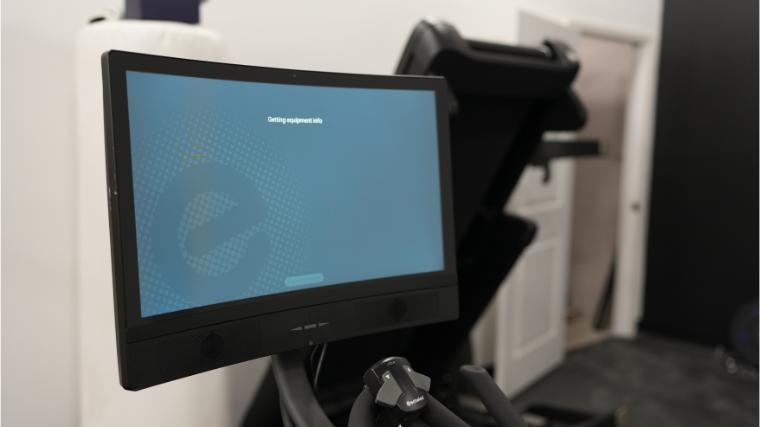
It has all the tech you’d expect from a smart bike — Bluetooth connectivity for headphones and heart rate monitors, along with fitness app integration — and a few you may not, like the LED wheel lights that can sync with your output or heart rate. The tech capabilities on the EX-8s earned a 5 out of 5 from our tester, a CrossFit Level 1 trainer, while they rated the programming on Echelon Fit a 4 out of 5.
“You can tell that it’s trying to emulate Peloton, but the production quality is not there yet. I do like that there are around 40 daily live classes, plus the around the world rides were just like iFIT’s,” they explained.
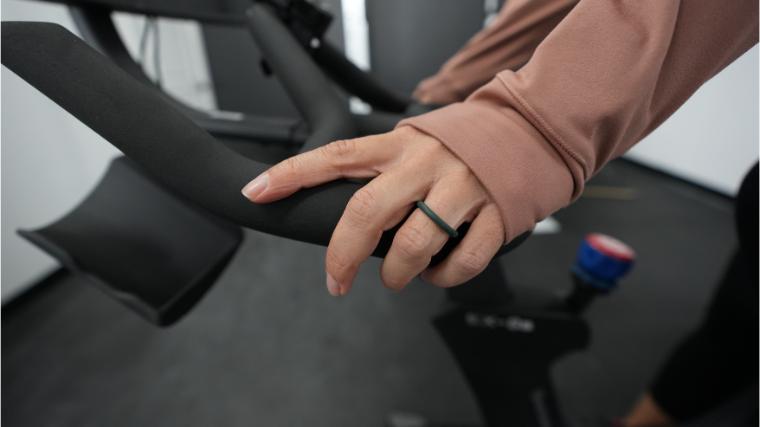
With multiple users likely climbing aboard, the ability to stream workouts and entertainment can provide enough variety for it to be a favorite in your gym. Another benefit of the membership is a 5-year warranty, which is much better than the 1-year warranty offered to non-members. The 1-year warranty did not sit well with our tester, who rated it a 3 out of 5 for durability. I didn’t see any issues with durability and the frame felt stable, but just a one-year warranty? Such a let down,” they said.
Read our full Echelon Connect EX-8s Exercise Bike Review.
Best Budget Commercial Exercise Bike: Yosuda YB001R Magnetic Exercise Bike

Smooth and quiet cycling with a 35 lb flywheel and attached transport wheels so you can cruise where you want to. Simple LCD screen with a lip for an iPad, tablet, or phone.
Specs
- Price: $279
- Dimensions: 45” H x 40” L x 22” W
- Display: LCD screen
- Weight: 68lbs
- Resistance: Magnetic
- Weight Capacity: 270lbs
Pros
- Even with a steel frame and 35-pound flywheel, it costs just $279 — well below the $1,200 to $2,000 average for commercial bikes.
- With such a heavy flywheel and a magnetic resistance system, you can expect this bike to hold up to consistent usage.
- Its 6.11-square-feet footprint is almost 2 square feet smaller than the average commercial bike.
Cons
- The levels of resistance are not labeled, so you’ll need to adjust them based on feel.
- While the steel frame seems solid, we noticed cracks forming in the seat during testing.
The Yosuda YB001R is our pick for best budget commercial exercise bike, because, compared to the average commercial bike, its $279 price tag can save you anywhere from $900 to $1,700. Even with its steel frame, heavy 35-pound flywheel, and magnetic resistance system, it only eats up 6.11 square feet of floor space, potentially leaving room for other pieces of budget home gym equipment.
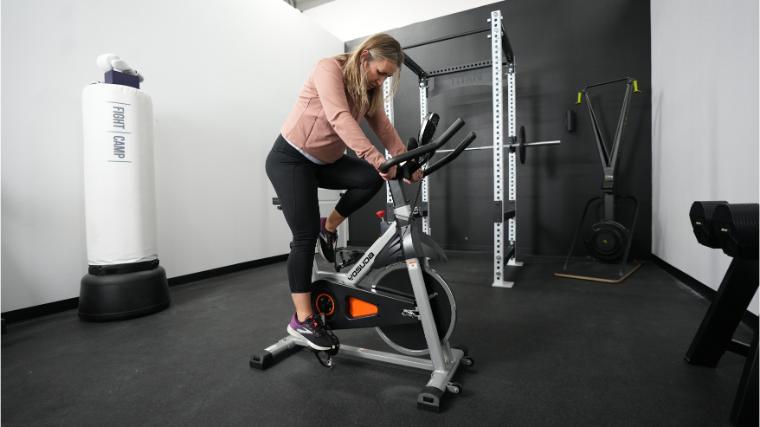
For roughly $300, it’s unlikely that this stationary bike will last as long as the pricier options on our list, but our tester still rated six out of 12 categories 3.5 out of 5 or higher, including its footprint, adjustability, and value. “I’d expect it to last a few years, which, for $300 is pretty good value. It may not be your forever bike, but is definitely a good option for anyone tight on space and cash,” they pointed out.
With a 35-pound flywheel and magnetic resistance system, you can at least count on minimal maintenance. Bikes with magnetic resistance tend to avoid some of the wear and tear brought on by the friction systems that use brake pads to slow down the flywheel. The resistance, however, is unlabeled, so you’ll need to get your own feel for it when settling in.

For a bike this affordable, there’s going to be some trade-offs. “Even after just a few rides, I noticed some tiny cracks in the seat cushion. Overall, though, it’s a heavy-duty bike and I thought it was surprisingly quiet,” they said,
Read our full Yosuda Exercise Bike Review.
Best Recumbent Commercial Exercise Bike: NordicTrack Commercial R35
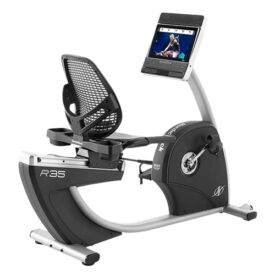
This recumbent bike features a 25-pound flywheel and 26 levels of magnetic resistance. With your purchase, you'll receive a 30-day trial to iFit, granting you access to over 16,000 workout classes ranging from cardio to strength training.
Specs
- Price: $1,499
- Dimensions: 53.42” H x 68.22” L x 23.69” W
- Display: 14” HD touchscreen
- Weight: 192lbs
- Resistance: 26 levels of magnetic resistance
- Weight Capacity: 350lbs
Pros
- With its oversized, adjustable seat and step-through design, this recumbent bike is perfect for those with limited mobility or back pain.
- The R35 can support users up to 350 pounds.
- Its steel frame and 25-pound flywheel can hold up to heavy use over time.
- iFIT integration allows users to stream over 17,000 live and on-demand workouts via the 14-inch HD touchscreen.
Cons
- With its heavy-duty construction and 192-pound overall weight, it can be difficult to move around.
- Access to iFIT’s workout library requires a $39.99 monthly subscription.
Adding a commercial recumbent bike like the NordicTrack R35 to your training space opens up access to low-impact cardio for senior athletes and those struggling with back or joint pain. (2) With a hefty steel-frame that can support users up to 350 pounds, you can expect the R35 to hold up to heavy usage for the long haul. Our tester, a CrossFit Level 1 trainer, rated its durability 4 out of 5, and called out its weight capacity. “Such a high user weight capacity makes it more inclusive and I, for one, felt zero shaking or movement at all while pedaling.”
If you’re debating the merits of recumbent bikes vs. upright bikes, here’s what our expert reviewer, Amanda Capritto, CPT, CF-L1, CES, CSNC, had to say about who may benefit from a recumbent exercise bike. “For people with lower back pain, cycling [on an upright exercise bike] may exacerbate that due to the positioning of the body on the bike,” Capritto explained. “Seniors and individuals with limited mobility may struggle to get on and off of an upright bike, in which case a recumbent bike is recommended.” (3)
[Related: The 6 Best Recumbent Bikes for Seniors]
The extra bit of support provided by the oversized seat and backrest were icing on the cake for our tester, who loved the low-intensity feel of their rides. “The R35 offers a great way to stay active or just do some passive cardio while watching TV or even reading,” they noted, rating its ergonomics 4 out of 5.
Beyond the build, users can cycle through hundreds of different workouts on iFIT, a fitness app which can be accessed via the R35’s 14-inch HD touchscreen. Whether they want to feel the heat in a studio class or take a virtual ride through Japan, iFIT provides immersion and variety for everyone from beginners to experienced riders.
Read our Full NordicTrack Commercial R35 Exercise Bike Review.
Best Commercial Exercise Bike with a Screen Holder: ProForm Carbon CX

The ProForm Carbon CX is a sturdy steel 125-pound build with 16 levels of silent magnetic resistance. In addition to being one of the quietest options on the market, this bike also comes with a free year of iFit and a swiveling tablet holder, so you can stream classes on and off the bike.
Specs
- Price: $399
- Dimensions: 51″ H x 52.5″ L x 21.9″ W
- Display: 180-degree swiveling tablet holder
- Weight: 125lbs
- Resistance: 16 levels of magnetic resistance
- Weight Capacity: 250lbs
Pros
- The swiveling screen holder allows you to set your own device on the console for streaming workouts or entertainment.
- Connect your device via Bluetooth to take advantage of iFIT’s automatic resistance control, as well as follow off-bike workouts.
- Despite its compact design, the steel frame still supports riders up to 250 pounds.
- Use the quick-adjust buttons on the console or knob to adjust the 16 levels of magnetic resistance.
Cons
- With no built-in screen, users will need to connect their own device to maximize its iFIT integration.
- This bike lacks convenient features like heart rate sensors, fans, and speakers.
The ProForm Carbon CX is our pick for best commercial bike with a screen holder because it is just that: a quality bike that can save you a bit of cash by using your own device instead of a display. Because it’s still integrated with iFIT, though, you can connect your own mobile device, hop into a live or on-demand virtual workout, and still use its automatic resistance control for hands-free adjustments. At just $399, it’s the most affordable bike we’ve used that comes with iFIT capability.
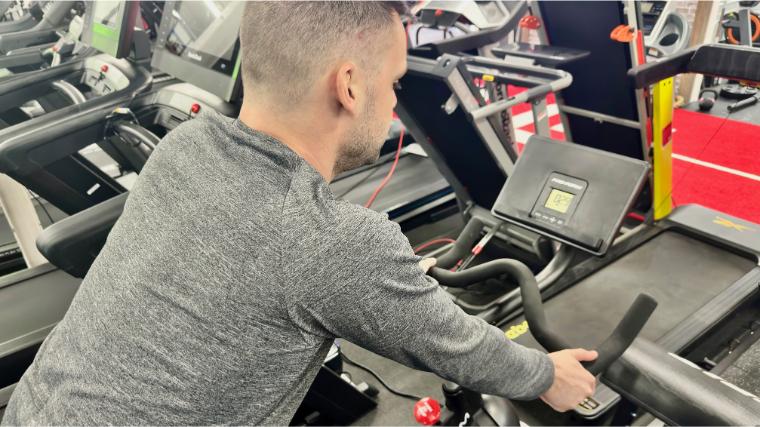
After connecting your device and sliding it in the screen holder, you can follow virtual studio classes or scenic rides on iFIT just like you would on a bike with a huge touchscreen. The screen holder even flips 180 degrees so you can maximize that iFIT membership with off-bike workouts like boxing, yoga, or strength training.
[Related: Best Budget Exercise Bikes]
While I wouldn’t consider its 28-pound flywheel to be heavy — about two pounds less than we like to see in commercial bikes — it did allow for smooth resistance adjustment every time I clicked the plus and minus buttons or turned the knob.
Its footprint of 7.98 square feet is right at the low end of the average range we see on commercial bikes — 8 to 9.5 square feet — so it may be a good fit in smaller gyms or fitness centers. For both portability and adjustability, our tallest tester (6 foot 3 inches), a certified personal trainer, gave the Carbon CX a 3.5 out of 5. “If I can find a comfortable fit on any exercise bike (especially compact models), most people probably can,” they explained. “Having a four-way adjustable seat sure helped.”

When I wheeled it around our gym, I scored the Carbon CX’s portability a 4.5 out of 5. I can see, however, how it may be more difficult to move around on thick carpet than our rubber gym flooring. Still, if you’re looking for a compact option that gives users the flexibility to slot in their own device, the $399 price point earned it a 4.5 out of 5 from both of us for value.
Read our full ProForm Carbon CX Exercise Bike Review.
Best Commercial Exercise Bike for Motivation: Peloton Bike

The bike that started the Peloton craze offers a 22-inch touchscreen, Bluetooth connectivity, a five-megapixel front-facing camera, and a built-in microphone. The Peloton membership offers access to thousands of live and on-demand cycling classes as well as progress tracking and leaderboards.
Specs
- Price: $1,445
- Dimensions: 51.25″ H x 51″ L x 24″ W
- Display: 21.5” HD touchscreen
- Weight: 135lbs
- Resistance: 100 levels of magnetic Resistance
- Weight Capacity: 297lbs
Pros
- The Peloton app’s charismatic instructors and top-notch studio classes may be the gold standard for engaging and motivating virtual workouts.
- With an alloy steel frame, 38-pound flywheel, and smooth belt-drive system, it’s built to last.
- Its 8.5-square-feet footprint makes it a solid option for smaller training spaces.
Cons
- The app’s $44 monthly subscription is $5 to $25 more expensive than other fitness apps.
- The pedals require Delta-compatible cleats, but can be swapped out for SPD pedals or toe cages.
The Peloton Bike itself is a quality machine with a steel frame and an impressive 38-pound flywheel, but there’s another reason Peloton has become synonymous with indoor cycling. BarBend editorial member and self-professed “Peloton Guy” Randall Colburn thinks the app’s vast library of live and on-demand classes are the best on the market. “I love being able to hop from a HIIT ride to an off-bike strength class to a yoga cooldown on the same app,” he said. “The instructors provide motivation, allow room for adjustments, and routinely make me laugh. I would die for Denis Morton.”

Our tester agrees. “What can I say about Peloton? The experience is top-notch, the instructors each bring their own flair to their classes, and the huge display brings it all to life.” Experiencing these classes through the 21.5-inch HD touchscreen was more than enough for the Peloton Bike to earn a 5 out of 5 for dynamic programming and a 4.5 out of 5 for tech capabilities. The quality will cost you, though — the Peloton app comes with a $44 monthly subscription fee, which is between $5 and $25 more expensive than other fitness apps.
[Related: Peloton vs. NordicTrack — How Do They Compare?]
In fact, we rated the Peloton at least a 4 out of 5 in all 12 categories, including durability, footprint and portability. With an footprint of 8.5 square feet, it’s on the low end of the average footprint — 8 to 9.5 square feet — making it a solid option for smaller gyms. It does, however, require Delta-compatible cleats or cycling shoes, so if you’re putting it in a public space, it may be worth swapping in SPD pedals or toe cages.

Though its 297-pound user weight is below the 350-pound weight capacities we’ve seen on comparable bikes — like the NordicTrack Commercial S22i — it remained steady and stable at high speeds. “There was zero shaking and the bike feels super sturdy. There are also floor stabilizers, which helped secure it in place,” said our tester, rating its durability a 4 out of 5.
What to Consider When Buying a Commercial Exercise Bike
Before laying down the cash for a commercial exercise bike, consider whether one will fit in your budget, then decide which option can best help you reach your goals. Our expert reviewer, Amanda Capritto, CPT, CF-L1, CES, CSNC, laid out what separates commercial machines from home ones.
“Commercial [machines] are the type you see in commercial gyms. They’re designed to withstand extremely high-volume use and they’re built with the manufacturers knowing hundreds, maybe thousands, of people will use them and not necessarily care for them like they are their own,” she says. Here are a couple things to help you know what to look for when buying an indoor cycle.
Frequency of Use
Exercise bikes that will be used in commercial or high-use settings — senior centers, apartment complexes, or big-box gyms — will need to withstand more use than a bike primarily used by one person. Commercial bikes tend to have the heft and versatility to stand up to the daily grind brought on by long endurance sessions, as well as high-intensity workouts. Having an idea of how often the machine will be used (and hopefully not abused) can give you a sense of exactly what kind of bike is the best match for your gym.
Type of Training
As many different clients or housemates will be saddling up on your commercial exercise bike, it’s important to consider their fitness goals. Consider the kinds of training users will want to accomplish on the bike and whether you’ll need to invest in top-of-the-line features like incline and decline, ultra-heavy flywheels, or fitness app integration to support them.

If the bike will live amongst CrossFit lovers, it may be worth it to opt for an air bike. If you’re setting it up in an assisted-living facility, a recumbent bike that’s easier on the joints may be better suited to your clientele. Once you have a clear picture of what different people want to accomplish, look for the features and specs that can make it happen.
Price
When you’re building out your home or commercial gym with quality fitness equipment, establishing your budget should be the first step. No matter what your number is, we think most people can find an option within our range of $279 to $3,079. As the high-grade materials and advanced technology features start to add up, so will the price.
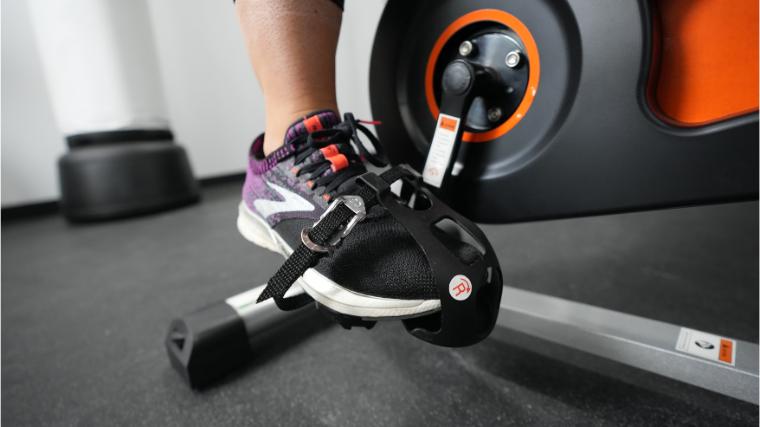
Before clicking checkout, consider exactly what the users in your gym or household value in an exercise bike. That may help you decide whether you can forgo a jumbo-sized HD touchscreen in the name of saving a bit of cash.
How Much Do the Best Commercial Exercise Bikes Cost?
While some commercial exercise bikes, depending on their features and specs, can push past $10,000, the majority of users can get the sweat they need on machines like the ones we included on our list. These options range from $279 to $3,079, but most come in between $1,000 and $2,000.
| Best Overall Commercial Exercise Bike | NordicTrack S22i | $1,999 |
| Best Peloton-Alternative Commercial Exercise Bike | ProForm Studio Bike Pro 22 | $1,299 |
| Best Commercial Air Bike | Assault Bike Classic | $699 |
| Best Smart Commercial Exercise Bike | Echelon Connect EX-8s | $3,079 |
| Best Budget Commercial Exercise Bike | Yosuda Indoor Cycling Bike | $279 |
| Best Recumbent Commercial Exercise Bike | NordicTrack Commercial R35 | $1,499 |
| Best Commercial Exercise Bike with a Screen Holder | ProForm Carbon CX | $399 |
| Best Commercial Exercise Bike for Motivation | Peloton Bike | $1,445 |
The exercise bikes closer to the $279 end of the range tend to lack the cutting-edge technology of the more expensive options, but every option on our list has a steel frame that can withstand frequent use. If your commercial exercise bike is going to see a steady stream of usage, it’s a good idea to invest in a quality machine that can support daily, constant use from a variety of riders.
Benefits of the Best Commercial Exercise Bikes
As commercial exercise bikes need to stand up to consistent use, they tend to feature sturdy builds and carry lengthy warranty options. With the rise in app-connected cardio machines, newer models may also feature dynamic programming like Peloton or iFIT. Check out a few of the benefits of the best commercial exercise bikes.
High-Quality Construction
Because commercial exercise bikes need to hold up to frequent use, the quality of their builds has to be top-notch. The best commercial exercise bikes will have steel frames, heavy flywheels of 30 pounds or more, and magnetic resistance systems that can help prolong their lifespan. As opposed to a friction system, bikes with magnetic resistance have magnets on either side of the flywheel that regulate the resistance level the user feels in the pedals. When the level is raised, the magnets move closer to the flywheel and it is more difficult to turn with the pedals.
Health Benefits
The best treadmills, rowers, and exercise bikes can help improve aerobic capacity, promote a healthy heart, and reduce blood pressure. (4) As these bikes can support a wide range of training options, many people can benefit from climbing in the saddle and spinning the pedals.

Our expert reviewer, Amanda Capritto, CPT, CF-L1, CES, CSNC, broke down the benefits of indoor cycling when she assessed exercise bikes for BarBend. “Cycling brings an impressive collection of health benefits to the table: cardiovascular health, endurance, stamina, muscular endurance are all improved with cycling, to name a few.” (4)
Some bikes on our list also integrate the best fitness apps and rotating or swiveling screens that allow users to grab dumbbells and resistance bands for off-bike workouts, giving them even more ways to reap the benefits of exercise.
Variety
To support multiple users, commercial exercise bikes tend to include a wide range of resistance levels, app integration, and, on occasion, incline and decline capabilities that can help athletes of all ages and fitness levels hit their goals.
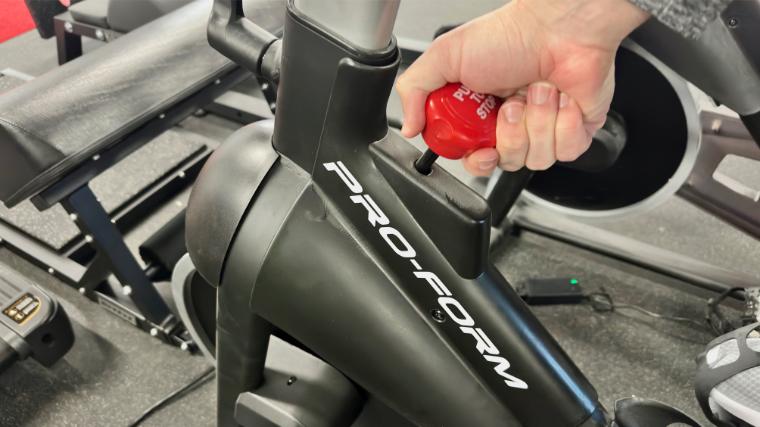
With more app-connected bikes hitting the market, having apps like iFIT and Peloton integrated with the machines can allow even more variety among cycling workouts, whether that’s via studio cycle classes or scenic rides. Commercial bikes with movable screens can also facilitate off-bike workouts like Pilates or yoga, further expanding the utility of these machines.
Final Word
Built to withstand the constant daily use of high-traffic commercial gyms and communal fitness centers, commercial exercise bikes can also be home gym essentials. With steel frames, heavy flywheels, high weight capacities, and fitness app integration, they can deliver the versatility and longevity to support a wide variety of riders.
Before investing in one of these bikes, consider the type of experience your users might expect. Do they enjoy the vibes of a virtual studio class? Maybe they’re after the full-body provided by an air bike. While the more affordable options on our list eschew some of the tech capabilities of the pricier bikes, all our picks have stood up to the scrutiny of our team of fitness professionals and have the quality construction to hold up over the long haul.
FAQs
What is the best commercial exercise bike?
The NordicTrack S22i is the best overall commercial exercise bike because it brings a little of everything — a steel frame, 32-pound flywheel, incline and decline, and iFIT integration. Riders up to 350 pounds can use the 22-inch HD touchscreen to immerse themselves in a live or on-demand ride with iFIT, or rotate the screen and hop off for some strength training or a yoga class.
What is a commercial exercise bike?
Commercial exercise bikes are designed to withstand heavy usage in high-traffic training spaces, like gyms, fitness centers, or just households full of cyclists. With brawny frames to support high user weights, heavy-duty flywheels, and magnetic resistance, these bikes are built to last. Some also pack in tech capabilities like touchscreens, along with WiFi and Bluetooth connectivity, allowing a variety of training for different types of athletes.
Which commercial bike is the best Peloton alternative?
While Peloton’s programming may be synonymous with at-home cycling, we think the ProForm Studio Bike Pro 22 is the best alternative. With iFIT onboard to provide live and on-demand rides — in the studio or around the world — and comparable displays, users can get a similar experience and reap the benefits of cycling for around $150 less.
References
- CPT, K. P., Tyagi, A., & Arendt, M. (2024, January 24). Magnetic vs friction exercise bike: An instructor explains. Girl Bike Love. https://girlbikelove.com/comparisons/magnetic-vs-friction-resistance-exercise-bikes
- Reiser, R. F., Broker, J. P., Peterson, M. L. (2004). Knee loads in the standard and recumbent cycling positions. Biomedical Sciences Instrumentation, 40, 36-42.
- Recumbent Bike vs. Upright Bike: What’s the difference? International Sports Sciences Association. (2019, July 31). https://www.issaonline.com/blog/post/recumbent-bike-vs-upright-bike-whats-the-difference)
- Chavarrias, M., Carlos-Vivas, J., Collado-Mateo, D., & Pérez-Gómez, J. (2019). Health Benefits of Indoor Cycling: A Systematic Review. Medicina (Kaunas, Lithuania), 55(8), 452.